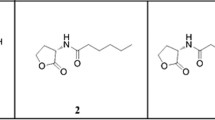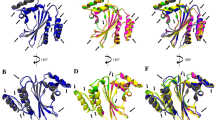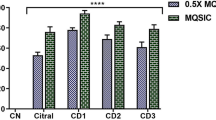Abstract
The increasing incidence of antimicrobial-resistant bacterial pathogens has focused researchers on quorum sensing inhibition strategies instead of those conventional approaches to fight bacterial infections. Anti-quorum sensing (QS) activity of aqueous extract from Forsythia suspense (FSE) was assessed, and its potential QS inhibition mechanisms were also analyzed. The minimal inhibitory concentration (MIC) of FSE to Chromobacterium violaceum 12472 is 0.5 mg mL−1. Inhibition of QS-regulated violacein production and biofilm formation in C. violaceum 12472 by FSE occurred in a concentration-dependent manner at sub-MIC, with > 70.12 and > 85.31% inhibition at 0.25 mg mL−1, respectively. N-Acyl homoserine lactones (AHLs) extracted from cultures of C. violaceum 31532 grown in the presence of FSE could not change the violacein production in C. violaceum 026, which indicated that FSE did not inhibit AHL synthesis. We also found that FSE cannot degrade AHLs. Finally, in silico molecular docking was conducted. The computed binding energy data suggested that components of F. suspense have a tendency to inhibit CviR with varying binding affinities and the energy score of Pinoresinol (− 26.02 kcal/mol) is higher than that of C6-HSL (− 16.09 kcal mol−1). We concluded that FSE acts as an antagonist of bacterial quorum sensing by competing with AHL receptor binding site.







Similar content being viewed by others
Explore related subjects
Discover the latest articles and news from researchers in related subjects, suggested using machine learning.References
Adonizio A, Leal SM, Ausubel FM, Mathee K (2008) Attenuation of Pseudomonas aeruginosa virulence by medicinal plants in a Caenorhabditis elegans model system. J Med Microbiol 57:809–813
Agarwala M, Choudhury B, Yadav RNS (2014) Comparative study of antibiofilm activity of copper oxide and iron oxide nanoparticles against multidrug resistant biofilm forming uropathogens. Indian J Microbiol 54:365–368
Ahmad A, Viljoen AM, Chenia HY (2015) The impact of plant volatiles on bacterial quorum sensing. Lett Appl Microbiol 60:8–19
Aliyu AB, Koorbanally NA, Moodley B, Singh P, Chenia HY (2016) Quorum sensing inhibitory potential and molecular docking studies of sesquiterpene lactones from Vernonia blumeoides. Phytochemistry 126:23–33
Bassler BL, Losick R (2006) Bacterially speaking. Cell 125:237–246
Blosser RS, Gray KM (2000) Extraction of violacein from Chromobacterium violaceum provides a new quantitative bioassay for N-acyl homoserine lactone autoinducers. J Microbiol Methods 40:47–55
Borges A, Abreu AC, Dias C, Saavedra MJ, Borges F, Simões M (2016) New perspectives on the use of phytochemicals as an emergent strategy to control bacterial infections including biofilms. Molecules 21:7
Bucio-Cano A, Reyes-Arellano A, Correa-Basurto J, Bello M, Torres-Jaramillo J, Salgado-Zamora H, Curiel-Quesada E, Peralta-Cruz J, Avila-Sorrosa A (2015) Targeting quorum sensing by designing azoline derivatives to inhibit the N-hexanoyl homoserine lactone-receptor CviR: synthesis as well as biological and theoretical evaluations. Bioorg Med Chem 23:7565–7577
Chan KG, Atkinson S, Mathee K, Sam CK, Chhabra SR, Koh CL, Williams P (2011) Characterization of N-acylhomoserine lactone-degrading bacteria associated with the Zingiber offinale (ginger) rhizosphere: co-existence of quorum quenching and quorum sensing in Acinetobacter and Burkholderia. BMC Microbiol 11:51
Chen G, Swem LR, Swem DL, Stauff DL, O'Loughlin CT, Jeffrey PD, Bassler BL, Hughson FM (2011) A strategy for antagonizing quorum sensing. Mol Cell 42:199–209
Chen J, Chen Q, Yu F, Huang H, Li P, Zhu J (2015) Comprehensive characterization and quantification of phillyrin in the fruits of Forsythia suspensa and its medicinal preparations by liquid chromatography–ion trap mass spectrometry. Acta Chromatogr 28:145–157
García-Contreras R, Peréz-Eretza B, JassoChávez R, Lira-Silva E, Roldán-Sánchez JA, González-Valdez A, Soberón-Chávez G, Coria-Jiménez R, Martínez-Vázquez M, Alcaraz LD, Maeda T, Wood TK (2015) High variability in quorum quenching and growth inhibition by furanone C-30 in Pseudomonas aeruginosa clinical isolates from cystic fibrosis patients. Pathog Dis 1174:344
Hozumi T, Matsumoto T, Ooyama H (1993) Antiviral agent containing crude drug. U.S. patent, 1174: 344
Jiao J, Gai QY, Wei FY, Luo M, Wang W, Fu YJ, Zu YG (2013) Biodiesel from Forsythia suspense [(Thunb.) Vahl (Oleaceae)] seed oil. Bioresour Technol 143:653–656
Kang WY, Wang JM (2010) In vitro antioxidant properties and in vivo lowering blood lipid of Forsythia suspense leaves. Med Chem Res 19:617–628
Koh CL, Sam CK, Yin WF, Tan LY, Krishnan T, Chong YM, Chan KG (2013) Plant-derived natural products as sources of anti-quorum sensing compounds. Sensors 13:6217–6228
Luo B, Zhang JZ (2013) Study on chemical constituents of extract of Forsythia suspense. Chin J Exp Tradit Med Formulae 19:143–146
Martinelli D, Grossmann G, Sequin U, Brandl H, Bachofen R (2004) Effects of natural and chemically synthesized furanones on quorum sensing in Chromobacterium violaceum. BMC Microbiol 4:1–10
Maurer S, Wabnitz GH, Kahle NA, Stegmaier S, Prior B, Giese T, Gaida MM, Samstag Y, Hansch GM (2015) Tasting Pseudomonas aeruginosa biofilms: human neutrophils express the bitter receptor T2R38 as sensor for the quorum sensing molecule N-(3-oxododecanoyl)-L-homoserine lactone. Front Immunol 6:369
McClean KH, Winson MK, Fish L, Taylor A, Chhabra SR, Camara M, Daykin M, Lamb JH, Swift S, Bycroft BW, Stewart GS, Williams P (1997) Quorum sensing and Chromobacterium violaceum: exploitation of violacein production and inhibition for the detection of N-acylhomoserine lactones. Microbiol 143:3703–3711
McLean RJ, Pierson LSIII, Fuqua C (2004) A simple screening protocol for the identification of quorum signal antagonists. J Microbiol Methods 58:351–360
Metzler K, Hansen GM, Hedlin P, Harding E, Drlica K, Blondeau JM (2004) Comparison of minimal inhibitory and mutant prevention drug concentrations of 4 fluoroquinolones against clinical isolates of methicillin susceptible and -resistant Staphylococcus aureus. Int J Antimicrob Agents 24:161–167
Mihalik K, Chung DW, Crixell SH, Mclean RJC, Vattem DA (2008) Quorum sensing modulators of Pseudomonas aeruginosa characterized in Camellia sinensis. Asian J Tradit Med 3:12–23
Musthafa KS, Sianglum W, Saising J, Lethongkam S, Voravuthikunchai SP (2017) Evaluation of phytochemicals from medicinal plants of Myrtaceae family on virulence factor production by Pseudomonas aeruginosa. APMIS 125:482–490
Ng WL, Bassler BL (2009) Bacterial quorum-sensing network architectures. Annu Rev Genet 43:197–222
Nishibe S, Okabe K, Tsukamoto H, Sakushima A, Hisada S, Baba H, Akisada T (1982) Studies on the Chinese crude drug Forsythiae fructus VI. The structure and antibacterial activity of suspersaside isolated from Forsythia suspensa. Chem Pharm Bull 30:4548–4553
Ozaki Y, Rui J, Tang Y, Satake M (1997) Antiinflammatory effect of Forsythia suspensa Vahl and its active fraction. Biol Pharm Bull 20:861–864
Piddock LJV (2017) Understanding drug resistance will improve the treatment of bacterial infections. Nat Rev Microbiol 15:639–640
Rattanaumpawan P, Sutha P, Thamlikitkul V (2010) Effectiveness of drug use evaluation and antibiotic authorization on patients' clinical outcomes, antibiotic consumption, and antibiotic expenditures. Am J Infect Control 38:38–43
Sarabhai S, Sharma P, Capalash N (2013) Ellagic acid derivatives from Terminalia chebula retz. downregulate the expression of quorum sensing genes to attenuate Pseudomonas aeruginosa PAO1 virulence. PLoS One 118:817–825
Sheng ZL, Li JC, Li YH (2011) Optimization of forsythoside extraction from Forsythia suspensa by Box-Behnken design. Afr J Biotechnol 10:11728–11737
Smith EE, Buckley DG, Wu Z, Saenphimmachak C, Hoffman LR, D'Argenio DA, Miller SI, Ramsey BW, Speert DP, Moskowitz SM (2006) Genetic adaptation by Pseudomonas aeruginosa to the airways of cystic fibrosis patients. Proc Natl Acad Sci U S A 103:8487–8492
Su W, Liu Q, Yang Q, Jiang SJ, Chen XQ (2014) Separation of four compounds from Forsythia suspensa by counter-current chromatography with stepwise clution. Sep Sci Technol 49:2098–2104
Subramaniyan S, Divyasree S, Sandhia GS (2016) Phytochemicals as effective quorum quenchers against bacterial communication. Recent Pat Biotechnol 10:153–166
Ta CA, Arnason JT (2015) Mini review of phytochemicals and plant taxa with activity as microbial biofilm and quorum sensing inhibitors. Molecules 21:E29
Taganna JC, Rivera WL (2008) Epigallocatechin gallate (EGCG) from Camellia sinensis is a potential quorum sensing inhibitor in Chromobacterium violaceum. Sci Diliman 20:24e30
Taganna JC, Quanico JP, Perono RMG, Amor EC, Rivera WL (2011) Tannin-rich fraction from Terminalia catappa inhibits quorum sensing (QS) in Chromobacterium violaceum and the QS-controlled biofilm maturation and LasA staphylolytic activity in Pseudomonas aeruginosa. J Ethnopharmacol 134:865–871
Tang K, Zhang XH (2014) Quorum quenching agents: resources for antivirulence therapy. Mar Drugs 12:3245–3282
Wang FN, Ma ZQ, Liu Y, Guo YZ, Gu ZW (2009) New phenylethanoid glycosides from the fruits of Forsythia Suspense (Thunb.) Vahl. Molecules 14:1324–1331
Zeng ZR, Qian L, Cao L, Tan H, Huang Y, Xue X, Shen Y, Zhou S (2008) Virtual screening for novel quorum sensing inhibitors to eradicate biofilm formation of Pseudomonas aeruginosa. Appl Microbiol Biotechnol 79:119–126
Zhang HY (2000) Advances in studies on chemical constituents of Forsythia suspensa and their pharmacological activities. J Chin Med Mater 23:657–660
Zhang A, Chu WH (2017) Anti-quorum sensing activity of Forsythia suspense on Chromobacterium violaceum and Pseudomonas aeruginosa. Pharmacogn Mag 13:321–325
Zhang QY, Liu YY, Wang CC, Fu ZL, Wang LF, Zhang LT (2017) Simultaneous quantification of eight constituents in the seed of Forsythia suspense (Thunb.) Vahl by HPLC-MS/MS method. Chin Tradit Herb Drugs 48:192–196
Zhao ZG, Yan SS, Yu YM, Mi N, Zhang LX, Liu J, Li XL, Liu F, Xu JF, Yang WQ, Li GM (2013) An aqueous extract of Yunnan Baiyao inhibits the quorum-sensing-related virulence of Pseudomonas aeruginosa. J Microbiol 51:207–212
Acknowledgments
This work was financed by the Priority Academic Program Development of Jiangsu Higher Education Institutions (PAPD).
Author information
Authors and Affiliations
Corresponding author
Ethics declarations
Conflict of Interests
The authors declare that there are no conflicts of interest regarding the publication of this paper.
Additional information
Publisher’s note
Springer Nature remains neutral with regard to jurisdictional claims in published maps and institutional affiliations.
Rights and permissions
About this article
Cite this article
Zhuang, X., Zhang, A. & Chu, W. Anti-quorum sensing activity of Forsythia suspense extract against Chromobacterium violaceum by targeting CviR receptor. Int Microbiol 23, 215–224 (2020). https://doi.org/10.1007/s10123-019-00091-3
Received:
Revised:
Accepted:
Published:
Issue Date:
DOI: https://doi.org/10.1007/s10123-019-00091-3




